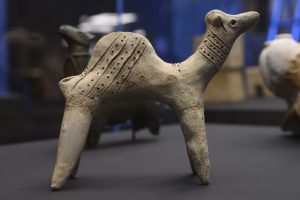Over the last few years, the Philadelphia Museum of Art has trumpeted a major $228 million renovation, designed by the architect Frank Gehry, that is to be completed next fall.
But over the last several months, the 144-year-old institution has been forced to undergo an overhaul of a very different kind.
Complaints that a manager, Joshua Helmer, had made advances toward multiple female employees during his tenure and that museum officials failed to respond to the women appropriately, have led to weeks of reckoning between the institution and its staff.
Mr. Helmer’s quiet resignation in 2018 seems to have done little to quell staff frustration. Since the complaints against him surfaced publicly in January, more than 400 current and former staff members have signed a letter calling for greater accountability and structural change at the museum. Some come to work each day wearing “We Believe Women” buttons.
“As someone who has worked at the museum for 20 years, I know they need to finish the renovation,” said Ah-Young Kim, a manager in the education department. “But can you imagine opening more galleries for programming and exhibitions when the staff is so defeated?”
The museum has sought to gain control of the situation, embarking on a staff-wide listening tour, commissioning a consultant to conduct a “cultural assessment” of the workplace and creating an anonymous hotline for reporting human resources-related violations or concerns.
“The museum is taking it really seriously,” said H. Richard Dietrich III, a trustee, who declined to comment further.
Still, there have been hitches. Only last month the museum had to answer for the behavior of yet another former executive, James A. Cincotta, who as retail director was said to have physically and verbally abused employees according to a report in the Philadelphia Inquirer. Mr. Cincotta did not respond to messages requesting comment.
And a counselor the museum hired to give staff members an opportunity to work through their frustrations at a difficult time was replaced after only one day on the job. The reasons were not disclosed.
These are not the sort of images usually associated with one of America’s oldest and most esteemed institutions. But they have become emblematic of the wider cultural discussion — fueled by the #MuseumMeToo moment — that art institutions have been forced to undertake as pressures build to reform their workplaces.
“Every institution I know is thinking very seriously about standards of personal and professional conduct,” said Gary Tinterow, director of the Museum of Fine Arts, Houston. “Meaningful conversations are happening everywhere.”
Parts of the conversation in Philadelphia are being directed by VallotKarp, a consulting firm the museum has hired to perform the “cultural assessment.” That assessment is to include an advisory team of 12 to 15 staff members, an optional survey, interviews and a focus group.
On Jan. 17, Leslie Anne Miller, the museum’s chairwoman, sent an email to staff members saying she would lead the assessment, which will include “reviewing existing policies and procedures and ensuring tangible, actionable and transparent results and recommended next steps.”
“We are working diligently and as quickly as we can to be responsive,” she added in the email. “However, we must balance quick action with the importance of being thoughtful and deliberate to be sure we are hearing and understanding all of your concerns.”
VallotKarp also explained the process at a staff-wide meeting that the museum held one day last month before the doors opened, thinking the early hour would enable most employees to attend.
“The meeting was extremely emotional but not well-attended,” Ms. Kim said. “It was held at 8:45 a.m. on a Friday, which was difficult for people with children or part-time jobs to attend because of the time. It was also difficult for the rest of the staff because it’s a day when many of us are expected to work later since the museum stays open until 8:45 p.m.”
Administrators have also retained Aorta, the Anti-Oppression Resource and Training Alliance, which has been meeting with small groups of employees who have confidentially shared their workplace experiences.
This kind of turmoil is not typically good for a museum leader, in this case Timothy Rub, who has been director since 2009. In memos to the staff, Mr. Rub has acknowledged “mistakes” and apologized for the handling of the Helmer incidents. He apologized again when the accusations surfaced about Mr. Cincotta. He has met with every department at the museum on a listening tour and held a town-hall meeting in late January.
But he has not publicly addressed the issues in any detail and his internal explanations have been similarly sparse in defining what exactly he is apologizing for. His reticence — along with that of the board — has fueled a feeling by some staff members that administrators have been opaque and remote in discussing their decision-making.
“I’m not sure this is coming from the right place,” said Brandon Straus, an audiovisual technician at the museum. “Maybe they will change their tactics from sweeping things under the rug. But what is their motivation? Protecting themselves or their employees?”
“Why should a cultural assessment have a bigger impact than our stories to human resources, the administration and the media?” he added.
Asked if Mr. Rub would comment for this article, a spokesman for the museum, Norman Keyes, said in an email: “At the moment the feeling here is to hold off on interviews with Timothy until after the work of the culture assessment is completed.”
Many trustees did not respond to interview requests, but there has been no indication that Mr. Rub has lost the support of the museum’s board.
In January, Mr. Helmer was forced to resign from his subsequent position as director of the Erie Museum of Art in Pennsylvania, where a female employee also complained of his conduct. Before his departure, the Erie museum said it had investigated the complaint and found no reason to discipline Mr. Helmer. He has denied any misconduct and defended his behavior as appropriate.
In Philadelphia, political pressure on the museum increased after the complaints regarding Mr. Helmer became public. Government leaders, including Philadelphia Mayor Jim Kenney, called on the museum to strengthen its policies regarding sexual harassment.
This type of negative attention is exactly what a museum does not want in the middle of a major capital campaign (its goal is $525 million, with $473 million raised so far). The museum says fund-raising remains on pace. But some donors have asked for explanations of recent events, according to people in the development office, who were provided suggested talking points in the event they faced questions from patrons.
“The museum is undertaking a range of thoughtful and deliberate actions,” one talking point began, “to result in a safer, stronger and more unified work environment.”
In one bright spot, employees say that weathering the controversy has fostered solidarity among those looking to improve their workplace. “Our departments used to be siloed and we didn’t know each other,” said an education staff member. “But that’s not true anymore. We talk and support each other.”
“It’s giving many of us a lot of hope that something positive is coming out of this,” she added.Other employees have decided that their time at the institution is over.
Marla Shoemaker, who had been Mr. Helmer’s direct supervisor, retired last month. She declined to discuss her reasoning beyond saying it was her decision to leave after 47 years.
“I adore the Philadelphia Museum of Art,” she said, before adding, “I can see it’s in deep trouble now. It makes me sad.”
Robin Pogrebin is a reporter on the Culture Desk, where she covers cultural institutions, the art world, architecture and other subjects. She is also the co-author of “The Education of Brett Kavanaugh: An Investigation.”
nytimes














